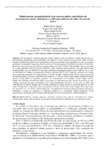Use este identificador para citar ou linkar para este item:
http://www.alice.cnptia.embrapa.br/alice/handle/doc/902307Registro completo de metadados
| Campo DC | Valor | Idioma |
|---|---|---|
| dc.contributor.author | AGUIAR, D. A. | pt_BR |
| dc.contributor.author | SILVA, W. F. | pt_BR |
| dc.contributor.author | MELLO, M. P. | pt_BR |
| dc.contributor.author | SILVA, G. B. S. da | pt_BR |
| dc.contributor.author | ADAMI, M. | pt_BR |
| dc.contributor.author | RUDORFF, B. F. T. | pt_BR |
| dc.contributor.author | CREPANI, E. | pt_BR |
| dc.contributor.author | VARLEZ, M. A. | pt_BR |
| dc.date.accessioned | 2011-10-04T11:11:11Z | pt_BR |
| dc.date.available | 2011-10-04T11:11:11Z | pt_BR |
| dc.date.available | 2011-10-04T11:11:11Z | pt_BR |
| dc.date.created | 2011-10-04 | pt_BR |
| dc.date.issued | 2011 | pt_BR |
| dc.identifier.citation | In: SIMPÓSIO BRASILEIRO DE SENSORIAMENTO REMOTO, 15., 2011, Curitiba. Anais... São José dos Campos: INPE, 2011. | pt_BR |
| dc.identifier.uri | http://www.alice.cnptia.embrapa.br/alice/handle/doc/902307 | pt_BR |
| dc.description | The potential for Brazilian sugarcane ethanol production and exportation is linked, among others, to environmental sustainability and certification. The objective of this work was to present the major activities carried out within the context of the Canasat Project that can contribute to the compliance of some certification guidelines for sustainable sugarcane ethanol production. The microregion of Auriflama in the State of São Paulo, Brazil was selected as study area. Remote sensing images from TM, AWiFS, CCD and HRC sensors were used to: 1) map sugarcane crop for crop year 2009/10; 2) map sugarcane harvest practice (with and without straw burning) during crop year 2009/10; 3) sugarcane cultivation in permanent protected areas (APP) by law; 4) land use and land cover change in remanescents of native vegetation (RVN), and 5) land use and land cover change due to sugarcane expansion. The municipalities of General Salgado, Magda and São João de Iracema presented the largest amount of cultivated sugarcane in the study area. It was also observed that pasture released the largest amount of land (80%) for sugarcane expansion. The municipalities of Guzolândia, Gastão Vidigal, Floreal, Magda and Auriflama presented the highest percentages of sugarcane harvested without the practice of straw burning surpassing the goal established by the Agri-environmental Protocolo for the year of 2009. The municipalities of General Salgado and Auriflama presented the largest amount of cultivated sugarcane in APP with 1.1% and 0.4%, respectively. The municipalities of Nova Castilho and Gastão Vidigal had, respectively, 68.7 ha (8.3%), 16.1 ha (4.5%) of RVN suppressed. The applied method and the integrated analyses allowed to, preliminary, evaluate the adherence of sugarcane producers to a sustainable ethanol production, in the microregion of Auriflama, based on some proposed directives for the certification of ethanol production. | pt_BR |
| dc.language.iso | por | pt_BR |
| dc.rights | openAccess | pt_BR |
| dc.subject | Cana-de-açúcar | pt_BR |
| dc.subject | Área de preservação permanente | pt_BR |
| dc.subject | Mudança de uso e cobertura da terra | pt_BR |
| dc.title | Monitoramento agroambiental do setor sucroenergético: contribuições do sensoriamento remoto orbital para a certificação ambiental do cultivo da cana-de-açúcar. | pt_BR |
| dc.type | Artigo em anais e proceedings | pt_BR |
| dc.date.updated | 2019-05-03T11:11:11Z | pt_BR |
| dc.subject.thesagro | Sensoriamento Remoto | pt_BR |
| dc.format.extent2 | p. 0132-0139. | pt_BR |
| riaa.ainfo.id | 902307 | pt_BR |
| riaa.ainfo.lastupdate | 2019-05-03 -03:00:00 | pt_BR |
| dc.contributor.institution | DANIEL ALVES AGUIAR, INPE; WAGNER FERNANDO SILVA, INPE; MARCIO PUPIN MELLO, INPE; GUSTAVO BAYMA SIQUEIRA DA SILVA, CNPM; MARCOS ADAMI, INPE; BERNARDO FRIEDRICH THEODOR RUDORFF, INPE; EDISON CREPANI, INPE; MARCO AURÉLIO VARLEZ, INPE. | pt_BR |
| Aparece nas coleções: | Artigo em anais de congresso (CNPM)  | |
Arquivos associados a este item:
| Arquivo | Descrição | Tamanho | Formato | |
|---|---|---|---|---|
| Gustavo5SBSR.pdf | 344,65 kB | Adobe PDF |  Visualizar/Abrir |









